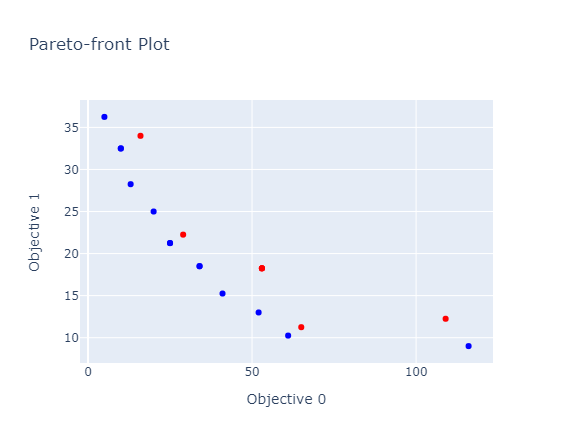Optuna Sweeper plugin
This plugin enables Hydra applications to utilize Optuna for the optimization of the parameters of experiments.
Installation
This plugin requires hydra-core>=1.1.0. Please install it with the following command:
pip install hydra-core --upgrade
You can install the plugin via pip:
pip install hydra-optuna-sweeper --upgrade
There are several standard approaches for configuring plugins. Check this page for more information.
Usage
Please set hydra/sweeper to optuna in your config file.
defaults:
- override hydra/sweeper: optuna
Alternatively, add hydra/sweeper=optuna option to your command line.
The default configuration is here.
Example 1: Single-Objective Optimization
We include an example in this directory. example/sphere.py implements a simple benchmark function to be minimized.
You can discover the Optuna sweeper parameters with:
# @package hydra.sweeper
sampler:
_target_: optuna.samplers.TPESampler
seed: 123
consider_prior: true
prior_weight: 1.0
consider_magic_clip: true
consider_endpoints: false
n_startup_trials: 10
n_ei_candidates: 24
multivariate: false
warn_independent_sampling: true
_target_: hydra_plugins.hydra_optuna_sweeper.optuna_sweeper.OptunaSweeper
direction: minimize
storage: null
study_name: sphere
n_trials: 20
n_jobs: 1
search_space:
x:
type: float
low: -5.5
high: 5.5
step: 0.5
'y':
type: categorical
choices:
- -5
- 0
- 5
The function decorated with @hydra.main() returns a float which we want to minimize, the minimum is 0 and reached for:
x: 0
y: 0
To run optimization, clone the code and run the following command in the plugins/hydra_optuna_sweeper directory:
python example/sphere.py --multirun
You can also override the search space parametrization:
python example/sphere.py --multirun 'x=interval(-5.0, 5.0)' 'y=interval(0, 10)'
You might find the optimization_results.yaml file (i.e. best params and best value) under multirun logs folder:
name: optuna
best_params:
x: 0.0
'y': 0
best_value: 0.0
Sampler configuration
This plugin supports Optuna's samplers.
You can change the sampler by overriding hydra/sweeper/sampler or change sampler settings within hydra.sweeper.sampler.
Search space configuration
This plugin supports Optuna's distributions to configure search spaces. They can be defined either through commandline override or config file.
Configuring through commandline override
Hydra provides a override parser that support rich syntax. Please refer to OverrideGrammer/Basic and OverrideGrammer/Extended for details.
Interval override
By default, interval is converted to UniformDistribution. You can use IntUniformDistribution, LogUniformDistribution or IntLogUniformDistribution by casting the interval to int and tagging it with log.
Example for interval override
python example/sphere.py --multirun 'x=int(interval(-5.0, 5.0))' 'y=tag(log, interval(1, 10))'
The output is as follows:
[HYDRA] Study name: sphere
[HYDRA] Storage: None
[HYDRA] Sampler: TPESampler
[HYDRA] Directions: ['minimize']
[HYDRA] Launching 1 jobs locally
[HYDRA] #0 : x=-3 y=1.6859762540733367
[HYDRA] Launching 1 jobs locally
[HYDRA] #1 : x=1 y=5.237816870668193
...
[HYDRA] Best parameters: {'x': 0, 'y': 1.0929184723430116}
[HYDRA] Best value: 1.1944707871885822
Range override
range is converted to IntUniformDistribution. If you apply shuffle to range, CategoricalDistribution is used instead.
Example for range override
python example/sphere.py --multirun 'x=range(-5.0, 5.0)' 'y=shuffle(range(-5, 5))'
The output is as follows:
[HYDRA] Study name: sphere
[HYDRA] Storage: None
[HYDRA] Sampler: TPESampler
[HYDRA] Directions: ['minimize']
[HYDRA] Launching 1 jobs locally
[HYDRA] #0 : x=-3 y=-4
[HYDRA] Launching 1 jobs locally
[HYDRA] #1 : x=1 y=-1
...
[HYDRA] Best parameters: {'x': 0, 'y': -1}
[HYDRA] Best value: 1.0
Choice override
choice is converted to CategoricalDistribution.
Example for choice override
python example/sphere.py --multirun 'x=choice(-5.0, 0.0, 5.0)' 'y=choice(0, 1, 2, 3, 4, 5)'
The output is as follows:
[HYDRA] Study name: sphere
[HYDRA] Storage: None
[HYDRA] Sampler: TPESampler
[HYDRA] Directions: ['minimize']
[HYDRA] Launching 1 jobs locally
[HYDRA] #0 : x=5.0 y=5
[HYDRA] Launching 1 jobs locally
[HYDRA] #1 : x=5.0 y=2
...
[HYDRA] Best parameters: {'x': 0.0, 'y': 0}
[HYDRA] Best value: 0.0
Configuring through config file
Int parameters
int parameters can be defined with the following fields:
type:intlow: lower boundhigh: upper boundstep: discretization step (optional)log: iftrue, space is converted to the log domain
If log is false, the parameter is mapped to IntUniformDistribution. Otherwise, the parameter is mapped to IntLogUniformDistribution. Please note that step can not be set if log=true.
Float parameters
float parameters can be defined with the following fields:
type:floatlow: lower boundhigh: upper boundstep: discretization steplog: iftrue, space is converted to the log domain
If log is false, the parameter is mapped to UniformDistribution or DiscreteUniformDistribution depending on the presence or absence of the step field, respectively. Otherwise, the parameter is mapped to LogUniformDistribution. Please note that step can not be set if log=true.
Categorical parameters
categorical parameters can be defined with the following fields:
type:categoricalchoices: a list of parameter value candidates
The parameters are mapped to CategoricalDistribution.
Example 2: Multi-Objective Optimization
In the same directory, example/multi-objective.py implements a simple benchmark function, which has two objective values. We want to minimize two objectives simultaneously.
You can discover the Optuna sweeper parameters with:
python example/multi-objective.py hydra/sweeper=optuna --cfg hydra -p hydra.sweeper
Configuration of the multi-objective optimization example
# @package hydra.sweeper
sampler:
_target_: optuna.samplers.NSGAIISampler
seed: 123
population_size: 50
mutation_prob: null
crossover_prob: 0.9
swapping_prob: 0.5
constraints_func: null
_target_: hydra_plugins.hydra_optuna_sweeper.optuna_sweeper.OptunaSweeper
direction:
- minimize
- minimize
storage: null
study_name: multi-objective
n_trials: 20
n_jobs: 1
search_space:
x:
type: float
low: 0
high: 5
step: 0.5
'y':
type: float
low: 0
high: 3
step: 0.5
To run the optimization, use the following command in the plugins/hydra_optuna_sweeper directory:
python example/multi-objective.py --multirun
For problems with trade-offs between two different objectives, there may be no single solution that simultaneously minimizes both objectives. Instead, we obtained a set of solutions, namely Pareto optimal solutions, that show the best trade-offs possible between the objectives. In the following figure, the blue dots show the Pareto optimal solutions in the optimization results.






